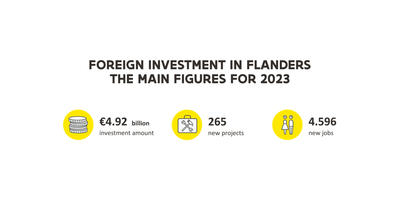
Why imec (Flanders) is the central link in the chip chain

“The neutral role and principle of open innovation were the main ingredients for imec's success,” explains Luc Van den hove. “Since it was founded in 1984 as the Interuniversity Microelectronics Center, imec has worked with every player, every university, every company in the micro- and nanotech industry.”
Innovation in chip technology is only possible if you bring everyone together.
Innovation throughout the chain
Broadly speaking, the chip industry falls into various parts:
- Firstly, you have the suppliers of materials and components. No product can be made without the right raw materials, components and devices, not even a chip. Raw materials and components come from firms like Fujifilm, Umicore, Inpria or – in the case of chip machine manufacturing – ASML.
- Then, there are the companies that design the chips. In some cases, chip design is done by players that also produce them afterwards – think of fully integrated firms such as Intel or Samsung. But there are also companies that design without operating (large) production capacity themselves, such as Qualcomm, Texas Instruments, Sony and ARM. The latter category outsources the production step to foundries and large production sites.
- Furthermore, production is followed by assembly and testing, which is often outsourced to specialized companies such as Amkor or JCET.
Imec works on innovation across this chain. Luc Van den hove: “We were able to claim that role because of our technical expertise, of course, but also because we were able to build an image of neutrality here in Flanders. As a research center, we are not dominated by one major player.”
Cooperation that makes the world go round
Quite the contrary, in fact! Virtually every company in the sector knocks on the strategic research center’s door for expertise. Highlighting just one number that pays testimony to this central role: imec currently participates in more than 500 ongoing collaborations with partners from all over the world.
Luc Van den hove zooms in on just one such collaboration: “Dutch chip machine manufacturer ASML, with whom we have had a very close relationship for 30 years, makes just about all the advanced chip production machines today. But if they want to improve their machines, they can only do it with the right materials, the right designs, the right processes. For that, they come to us.”
Unmatchable infrastructure
In addition to worldwide cooperation ties, imec also has its infrastructure and technical expertise to thank for its success. After more than three decades of operation, this infrastructure has become unmatchable. In one of its clean rooms, for instance, imec houses the most advanced pilot line in the world.
Luc Van den hove: “One machine can easily cost up to EUR 200 million. It’s no longer feasible today for companies to have such machines in-house for testing purposes. But at imec, we do – and we also have the infrastructure to test materials, to give feedback on designs, etc.”
The future is chip based
Imec is clearly poised for a bright future. “In the past, when people thought of chips, they thought of computers and smartphones,” says Luc Van den hove. “But today, no industry can do without them.”
From health to food, agriculture and communications – think 5G or even 6G – and even automotive: virtually every industry relies on chip-based innovations and applications. For instance, 80% of innovation in cars relates to electronics.
It should therefore come as no surprise that the chip market is expected to double – again – in the next ten years, growing from USD 440 billion in 2020 to more than USD 800 billion in 2030. And that figure covers just the chips, not the products of which they are the cornerstone. The value of those is estimated in the trillions of dollars.


